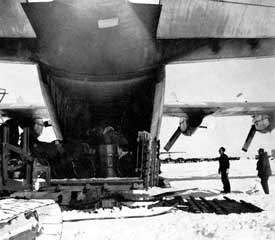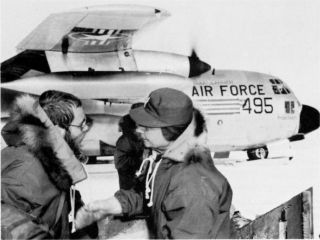Air Force C-130 operations in DF-60 Above (USN; credits below), a dog team meets the first aircraft just after landing at McMurdo at 1755 on 23 January 1960. It was piloted by squadron commander Lt. Col. Wilbert Turk. The 61st Troop Carrier Squadron from Sewart AFB, Tennessee, brought 7 of their 12 ski-equipped C-130-D aircraft to the ice, as well as a wheeled C-130-A that did not venture south of ChCh. During 1957 and early 1958, the Air Force did extensive testing of a ski-configured Herc. Based on the results, in 1958 twelve C-130-A's had been converted to the ski model D's. The primary intended mission was to haul heavy cargo and passengers for construction and support of the DYE-2 and DYE-3 DEW Line sites on the Greenland icecap. There were a total of 28 flights to Pole, as well as 30 to Byrd plus some field camp support between 25 January and 5 February 1960.   At left, another later Air Force flight to McMurdo is also greeted by a dog team from Scott Base (WMN). At left, another later Air Force flight to McMurdo is also greeted by a dog team from Scott Base (WMN).At right, a map depicting the main Air Force supply routes to Byrd and Pole (LG).
At right, drums of aviation gasoline are being
loaded at McMurdo for delivery to Byrd (USN). According to this letter from Col. Wilbert Turk, USAF (RET): "...the emergency airlift was essential because the two US stations in Antarctica would be abandoned unless essential equipment and supplies could be provided for the wintering over party. Remember at that time the Antarctica treaty had not been agreed to and if the US abandoned its sites, another nation (the USSR) would occupy them." Col. Turk documents the squadron activity and references the original Aviation Week feature ("Wings over Antarctica" published May 25, 1998 and not available online). He commanded the group and made the first landings at Byrd and Pole. Was Col. Turk right about the Russians taking over? Of interest..the Central Intelligence Agency (CIA) issued this report (which was originally classified SECRET) about the traverse plans. After all, the Russians had made their first land traverse to Pole only a month before the Air Force aircraft showed up. It is now known that the USSR could not have resupplied Pole for winter operations, but what was known in December 1959? It is interesting to note from the cruisebook photos and other documentation that the arrival of the Air Force aircraft seemed to be a last-minute plan, as the Public Works folks had to scramble to prepare a new skiway for these aircraft on short notice. And at least from the quantity of cargo delivered, it is not inconceivable that the inland stations would have lacked adequate supplies for a winter if the extra airlift had not happened.
The final unit statistics: Total ski landings: 128Average flights/day: 7 Total flight hours: 1104 Cargo: 407 tons total (Pole and Byrd) Manning: 131 officers and men 10 flight crews Average of 7.3 missions/flight crew Credits: (USN) U. S. Navy photos from the DF-60 Task Force 43 cruisebook. (WMN) William "Bill" Nichols, 61st TCS Pilot, photo from the Firebirds.org C-130D page (which may also be unavailable). (LG) Lockheed Georgia; this photo was included in the article "Skibirds on the Ice Cap" by John H. Cloe, published in the American Aviation Historical Society Journal, Vol. 22, No. 2, Summer 1977. In addition to the above sources and assistance from Bruce DeWald, other background and statistics came from the Bulletin of the U. S. Antarctic Projects Officer,, Volume 1, No. 5 (January 1960) and No. 9 (May 1960). |


